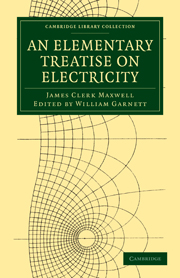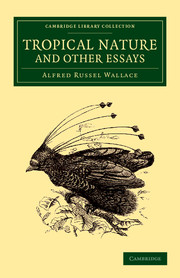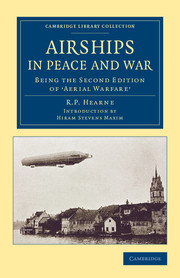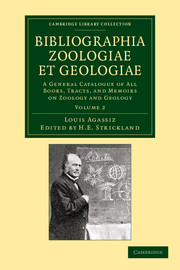Refine search
Actions for selected content:
10306 results in History of science: general interest
The power of partnerships: the Liverpool school of butterfly and medical genetics
-
- Journal:
- The British Journal for the History of Science / Volume 47 / Issue 4 / December 2014
- Published online by Cambridge University Press:
- 29 April 2014, pp. 677-699
- Print publication:
- December 2014
-
- Article
- Export citation
‘Most rare workmen’: optical practitioners in early seventeenth-century Delft
-
- Journal:
- The British Journal for the History of Science / Volume 48 / Issue 1 / March 2015
- Published online by Cambridge University Press:
- 12 March 2014, pp. 53-85
- Print publication:
- March 2015
-
- Article
- Export citation

Bibliographia zoologiae et geologiae
- A General Catalogue of All Books, Tracts, and Memoirs on Zoology and Geology
-
- Published online:
- 05 March 2014
- Print publication:
- 04 July 2013

An Elementary Treatise on Electricity
-
- Published online:
- 05 March 2014
- Print publication:
- 30 June 2011
- First published in:
- 1881

Tropical Nature and Other Essays
-
- Published online:
- 05 March 2014
- Print publication:
- 06 June 2013
- First published in:
- 1878
John Flamsteed and the turn of the screw: mechanical uncertainty, the skilful astronomer and the burden of seeing correctly at the Royal Observatory, Greenwich
-
- Journal:
- The British Journal for the History of Science / Volume 48 / Issue 1 / March 2015
- Published online by Cambridge University Press:
- 05 March 2014, pp. 17-51
- Print publication:
- March 2015
-
- Article
- Export citation

Airships in Peace and War
- Being the Second Edition of Aerial Warfare
-
- Published online:
- 05 March 2014
- Print publication:
- 27 June 2013
- First published in:
- 1910

Bibliographia zoologiae et geologiae
- A General Catalogue of All Books, Tracts, and Memoirs on Zoology and Geology
-
- Published online:
- 05 March 2014
- Print publication:
- 04 July 2013
Paolo Sarpi and the first Copernican tidal theory
-
- Journal:
- The British Journal for the History of Science / Volume 47 / Issue 4 / December 2014
- Published online by Cambridge University Press:
- 26 February 2014, pp. 661-675
- Print publication:
- December 2014
-
- Article
- Export citation
‘A thorn in the side of European geodesy’: measuring Paris–Greenwich longitude by electric telegraph
-
- Journal:
- The British Journal for the History of Science / Volume 47 / Issue 4 / December 2014
- Published online by Cambridge University Press:
- 19 February 2014, pp. 637-660
- Print publication:
- December 2014
-
- Article
- Export citation
Piers Mitchell (ed.), Anatomical Dissection in Enlightenment England and Beyond: Autopsy, Pathology and Display. Farnham: Ashgate, 2012. Pp. xi + 186. ISBN 978-1-409-41886-3. £60.00 (hardback).
-
- Journal:
- The British Journal for the History of Science / Volume 47 / Issue 1 / March 2014
- Published online by Cambridge University Press:
- 14 February 2014, pp. 184-185
- Print publication:
- March 2014
-
- Article
- Export citation
Monica Azzolini, The Duke and the Stars: Astrology and Politics in Renaissance Milan. Cambridge, MA and London: Harvard University Press, 2013. Pp. xiii+370. ISBN 978-0-674-06663-2. £36.95 (hardback).
-
- Journal:
- The British Journal for the History of Science / Volume 47 / Issue 1 / March 2014
- Published online by Cambridge University Press:
- 14 February 2014, pp. 176-178
- Print publication:
- March 2014
-
- Article
- Export citation
BJH volume 47 issue 1 Cover and Front matter
-
- Journal:
- The British Journal for the History of Science / Volume 47 / Issue 1 / March 2014
- Published online by Cambridge University Press:
- 14 February 2014, pp. f1-f2
- Print publication:
- March 2014
-
- Article
-
- You have access
- Export citation
Spencer R. Weart, The Rise of Nuclear Fear. Cambridge, MA and London: Harvard University Press, 2012. Pp. ix+367. ISBN 978-0-674-05233-8. £16.95 (paperback).
-
- Journal:
- The British Journal for the History of Science / Volume 47 / Issue 1 / March 2014
- Published online by Cambridge University Press:
- 14 February 2014, pp. 193-194
- Print publication:
- March 2014
-
- Article
- Export citation
Nancy G. Siraisi, Communities of Learned Experience: Epistolary Medicine in the Renaissance. Baltimore: Johns Hopkins University Press, 2013. Pp. xii+163. ISBN 978-1-4214-0749-4. £23.50 (hardback).
-
- Journal:
- The British Journal for the History of Science / Volume 47 / Issue 1 / March 2014
- Published online by Cambridge University Press:
- 14 February 2014, pp. 178-179
- Print publication:
- March 2014
-
- Article
- Export citation
BJH volume 47 issue 1 Cover and Back matter
-
- Journal:
- The British Journal for the History of Science / Volume 47 / Issue 1 / March 2014
- Published online by Cambridge University Press:
- 14 February 2014, pp. b1-b5
- Print publication:
- March 2014
-
- Article
-
- You have access
- Export citation
Manfred Horstmanshoff, Helen King and Claus Zittel (eds.), Blood, Sweat and Tears: The Changing Concepts of Physiology from Antiquity into Early Modern Europe. Leiden: Brill, 2012. Pp. xxvi+772. ISBN 978-90-04-22918. €217.00 (hardback).
-
- Journal:
- The British Journal for the History of Science / Volume 47 / Issue 1 / March 2014
- Published online by Cambridge University Press:
- 14 February 2014, pp. 175-176
- Print publication:
- March 2014
-
- Article
- Export citation
Marcel Chotkowski LaFollette, Science on American Television: A History. Chicago and London: The University of Chicago Press, 2013, Pp. x+306. ISBN 978-0-226-92199-0. £29.00 (hardback).
-
- Journal:
- The British Journal for the History of Science / Volume 47 / Issue 1 / March 2014
- Published online by Cambridge University Press:
- 14 February 2014, pp. 189-191
- Print publication:
- March 2014
-
- Article
- Export citation
Kristian H. Nielsen, Michael Harbsmeier and Christopher J. Ries (eds.), Scientists and Scholars in the Field: Studies in the History of Fieldwork and Expeditions. Aarhus: Aarhus University Press, 2012. Pp. 476. ISBN 978-87-7124-014-6. £50.00 (hardback).
-
- Journal:
- The British Journal for the History of Science / Volume 47 / Issue 1 / March 2014
- Published online by Cambridge University Press:
- 14 February 2014, pp. 188-189
- Print publication:
- March 2014
-
- Article
- Export citation
Books received
-
- Journal:
- The British Journal for the History of Science / Volume 47 / Issue 1 / March 2014
- Published online by Cambridge University Press:
- 14 February 2014, pp. 195-197
- Print publication:
- March 2014
-
- Article
- Export citation
